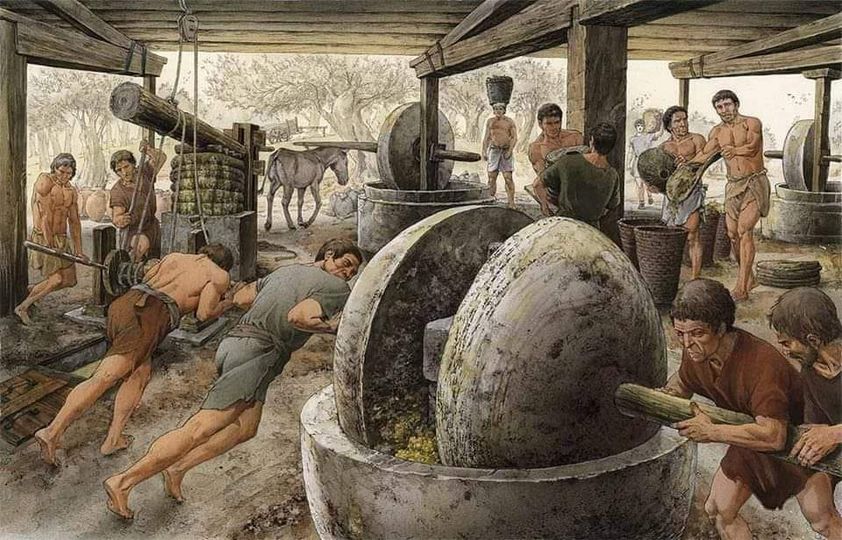Olive oil was far more than a simple culinary ingredient in ancient Rome. It illuminated homes by fueling lamps, played a crucial role in elaborate bathing rituals, and served as a medicinal balm, making it indispensable in the daily lives of Roman citizens. Its significance was so profound that it spurred the growth of a vast industry centered on its production, trade, and transportation, reflecting the sophistication and economic priorities of Roman society.

The production of olive oil was an intricate process, typically carried out on agricultural estates, or villas, where skilled labor and specialized equipment ensured the highest quality product. Olives were carefully hand-harvested to preserve their integrity and transported to a dedicated space known as the tabulatum. This room featured a waterproof, inclined floor designed to collect alpechín, a liquid byproduct that was repurposed as an effective insecticide and herbicide. Such meticulous attention to detail underscores the ingenuity of Roman agricultural practices.
The process of producing olive oil required precise techniques to maintain its flavor and quality. Olives were crushed in mills called trapetum, which were specifically designed to avoid breaking the pits. This step was considered essential, as broken pits could impart bitterness to the oil. The crushing process created an olive paste, which was then transferred to a pressing area known as the torcularium, the very heart of olive oil extraction.
The torcularium was equipped with robust presses, constructed either of wood or stone, capable of exerting substantial pressure to extract the maximum yield from the olive paste. These presses reflected the advanced engineering capabilities of the Romans. Once the oil was extracted, it was collected in large ceramic containers known as dolia, which were often partially buried in the ground. This ingenious storage method helped maintain a stable temperature, preserving the oil’s quality and preventing spoilage.
Once extracted, the oil underwent a careful storage process in specialized rooms called cella olearia. These storage facilities played a critical role in preserving the oil, ensuring its quality during transport across the vast Roman Empire. Among the varieties of olive oil produced, the most prized was oleum omphacium, made from green, unripe olives harvested early in the season, typically in September. This premium oil was reserved for the wealthiest households and renowned for its exceptional purity and rich taste, symbolizing luxury and refinement.
Spain, referred to as Hispania during Roman times, became a central hub for olive oil production, particularly in the southern regions that today form Andalucía. The region’s olive oil was celebrated for its superior quality, making it a staple export throughout the Mediterranean. Hispania’s vast production capacity and strategic location positioned it as a vital contributor to the Roman economy. The trade of olive oil not only sustained Rome’s economic engine but also reinforced its social structures, as the availability and quality of olive oil often mirrored the wealth and status of its consumers.
The role of olive oil extended far beyond practical uses in Roman society. It became a powerful symbol of prosperity, culture, and refinement. Olive oil permeated nearly every aspect of Roman life. In cuisine, it elevated dishes with its rich flavor; in medicine, it was used as a healing balm; in personal hygiene, it was an integral part of bathing rituals; and in lighting, it illuminated Roman homes and public spaces alike. These diverse uses underscore its unparalleled importance in daily life.
The extensive industry that developed around olive oil production highlights the technological and agricultural advancements of Roman society. From innovative harvesting and crushing techniques to sophisticated storage and transport methods, the Romans demonstrated a mastery of processes that ensured both efficiency and quality. Furthermore, the widespread trade of olive oil showcased the Empire’s interconnected economy, linking regions as distant as Hispania, North Africa, and the Middle East to the heart of Rome.
This thriving industry also reflected the hierarchical nature of Roman society. High-quality olive oils, such as oleum omphacium, were reserved for the elite, serving as a marker of wealth and prestige. In contrast, more affordable grades of oil were consumed by the general population, highlighting the economic disparities that existed within the Empire.
The olive oil trade also underscored the strategic importance of regions like Hispania, whose fertile lands and skilled labor contributed significantly to the Empire’s wealth. The logistical complexity of transporting olive oil across the Mediterranean, using amphorae loaded onto ships, further demonstrates the Romans’ advanced understanding of trade and commerce. The presence of olive oil amphorae in archaeological sites across Europe and beyond provides tangible evidence of its economic and cultural significance.
Olive oil’s role in Roman culture cannot be overstated. Beyond its practical applications, it symbolized the sophistication of Roman civilization. It represented innovation in agriculture and engineering, serving as a testament to the Empire’s ability to harness natural resources for widespread use. At the same time, it reinforced societal values, as its production and distribution were tightly linked to concepts of class and status.
The story of olive oil in ancient Rome is, in many ways, a reflection of the Empire itself—a blend of practicality and luxury, innovation and tradition. From the estates of Hispania to the bustling markets of Rome, olive oil was a unifying element that connected people across regions and social classes. Its enduring legacy is evident even today, as olive oil continues to be a staple of Mediterranean culture and cuisine.
By understanding the central role olive oil played in ancient Rome, we gain deeper insights into the daily lives, economic priorities, and cultural values of one of history’s most influential civilizations. The ingenuity and dedication involved in its production remind us of the remarkable achievements of the Romans, whose legacy continues to shape our world in countless ways.





